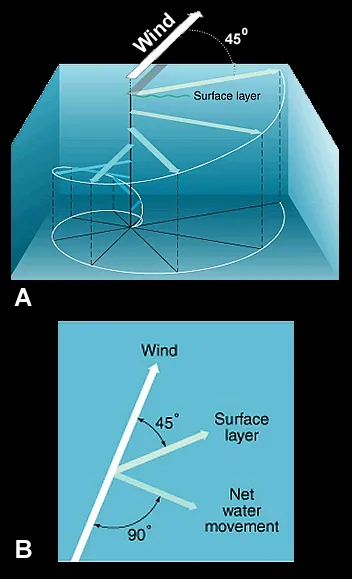How Seawater Moves: Ekman Transport
An explorer from Norway named Fridtjof Nansen froze his ship into the Arctic sea ice in 1893. He did this on purpose. He thought that trapped in sea ice, which moves with ocean currents, he would get to the North Pole eventually. For three years, Nansen and his ship drifted through the Arctic. He didn’t make it to the Pole. But he did have lots of time to make observations of the environment. One of his observations was that the ice was not moving in the same direction as the wind. It was moving consistently to the right of the wind direction. This phenomenon would later become known as Ekman transport.
As wind blows across the ocean, it moves water because of friction at the ocean surface. Because the Earth rotates, surface water moves to the right of the wind direction in the Northern Hemisphere and to the left of the wind direction in the Southern Hemisphere due to the Coriolis effect.
The speed and direction of the moving water changes with depth. Ocean water at the surface moves at an angle to the wind, and the water under the surface water turns a bit more, and the water below that turns even more. This makes a spiral of moving water 100 to 150 meters (330 to 500 ft) deep called an Ekman spiral. The average direction of all this turning water is about a right angle from the wind direction. This average is Ekman transport.
The Ekman spiral and Ekman transport are named for Swedish scientist V. Walfrid Ekman who first described the spiral in 1905. To help him make a mathematical model of these movements, Ekman used the observations that Fridtjof Nansen made while frozen into the Arctic sea ice.

An Ekman spiral (A) is a rotating column of water that forms when water moves at an angle to the wind direction due to the Coriolis Effect. The net effect of the rotating water (B) is movement at a right angle to the wind direction. The example shown above is for the Northern Hemisphere. The water turns to the left instead of the right in the Southern Hemisphere.
NOAA
© 2008 NESTA